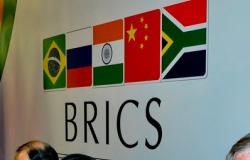Breaking BRICS: More Differences Than Similarities?

This month brings the tenth summit of the fast-growing BRICs nations – Brazil, Russia, India, and China and South Africa. But does the label still hold given the countries' starkly different political and economic realities?
Almost 17 years after Goldman Sachs coined the term “BRICs” for Brazil, Russia, India, and China, and later South Africa, a group of fast-growing economies challenging the West’s global economic leadership, the nations will gather at a summit in Johannesburg from July 25 to 27.
In fact, while all BRICS nations have grown significantly over the past two decades, and have made great strides in eliminating extreme poverty, the question remains whether the group forms a meaningful socio-economic or geopolitical bloc at all. The BRICS countries’ cooperation has been limited and they have begun to significantly diverge in terms of economic performance, with only India and China sustaining high growth.
The BRICS are a very heterogeneous group of nations, united neither by ideology, geography, or culture. They are all emerging markets and can claim a leadership role, if only by their size, in their respective regions. Their only real shared interest is their common opposition to the ‘Euro-American club’ which has dominated the world economy since the nineteenth century, and their rejection of what they view as Western or international ‘meddling’ in their internal affairs.
Where's the BRIC's club?
Beyond this shared global view, these countries have made some moves towards more economic cooperation. In 2015, they founded the New Development Bank, as an alternative to traditional institutions such as the World Bank and the International Monetary Fund, with $100 billion of capital to invest in development projects. The BRICS have furthermore committed another $100 billion to the so-called Contingent Reserve Arrange, a special fund to be used to protect their economies from financial instability and currency speculation.
Further moves towards unity have been modest, despite occasional suggestions that the BRICS ought to create some sort of rival reserve currency to the U.S. dollar or an alternative to the SWIFT international payments system. So far, the BRICS’ cooperation has not approached anything like that found among Western countries within NATO or the European Union, and this seems unlikely to change.
And while in the early 2000s, every BRICS nation was rapidly catching up economically with the West, this has not held true for several years. While the giants China and India are still steaming ahead, Russia is retrenching. Brazil and South Africa, meanwhile, are falling behind.
Brazilians are fundamentally disenchanted with politics
An ungenerous proverb has it that: “Brazil is a country of the future... and always will be.” Sadly, recent events at least seem to confirm this judgment. Brazil’s political life is wracked by widespread corruption, politicized courts, and fierce divisions within the political elite. The fall in raw material prices and collapsing investor confidence have shaken the economy. While unemployment is high (12.6 percent) and per capita Gross Domestic Product (GDP) has declined, the economy’s current mediocre performance is in fact already being artificially propped up by unsustainable deficit spending. Public debt has exploded from 51.5 percent of GDP in 2013 to 74 percent in 2017, while last year’s budget deficit stood at 7.8 percent of GDP. On the social level, Brazil remains one of the most unequal and violent nations in the world, with 61,283 murders in 2016. Furthermore, there has been little reduction in the country’s racial inequality, despite previous years of economic growth.
Brazilians themselves have become disenchanted with their regime. As the Bertelsmann Transformation Index (BTI) report for Brazil notes: “Brazil is one of the countries with the lowest support for democracy in Latin America. In 2016, the share of respondents that prefer democracy over any other form of government was only 32 percent, the second lowest percentage, ahead only of Guatemala. Support for an authoritarian regime under some circumstances reached 55 percent in 2016”. The economic crisis, social dysfunction, and political division in Brazil suggest that, despite its size and bountiful resources, the country will continue to lack the organization to project much power abroad.
South Africa struggles
The situation is even worse in South Africa, a country which is struggling with even higher poverty, inequality, unemployment, and often horrific violence. The South African economy has featured low-to-no growth in recent years, 27 percent unemployment, and steadily-rising debt, which ballooned from 27.8 percent of GDP in 2008 to 53.1 percent last year. The country risks falling into a debt trap, as debt-financing, the fastest growing budget item, already sucks up 10 percent of government spending. South Africa’s BTI report notes: “Not since its launch in 2012 has the country come close to the National Development Plan’s target annual growth of 5.4 percent to eradicate poverty and significantly reduce inequality by 2030. In 2015, GDP growth stood at a paltry 0.5 percent.”
Ethnic and familial nepotism is rife in South Africa, going right up to the former president, Jacob Zuma, who used public funds to renovate his private home. The country remains racially polarized, with “low levels of trust between the country’s historically-defined racial groups”, and with “most South Africans still living in very racially homogeneous neighborhoods”. Furthermore, black South Africans, who are divided into many ethnic groups, have themselves increasingly revealed “latent xenophobic attitudes” through attacks on fellow African migrants. With declining respect for the right to free association, freedom of expression, and the separation of powers, South Africa’s BTI score for democracy has declined from 8.7 out of 10 in 2006 to just 7.6 today.
Emigration from South Africa is also high, with large numbers of white, qualified, and/or skilled citizens leaving to escape the country’s crime and dysfunction, and in search of better economic opportunities. On the economic, social, and political fronts, South Africa has then largely stalled: the country may remain an influential actor within Africa, but is in many respects no longer a role model.
Russia's economy stalls
That leaves Russia, India, and China, three countries with stronger pretensions to being great powers. Russian foreign policy has increasingly been defined by conflict with the West, notably due to Moscow’s military support for Syrian President Bashar Al-Assad, the annexation of Crimea, and support for eastern Ukrainian secessionists. Western sanctions have taken a moderate toll on the country’s economy.
While the Kremlin has shown impressive macroeconomic discipline – despite recession, public debt is a mere 12.6 percent of GDP and unemployment stands at a low 4.7 percent – economic growth has stalled. But Russia’s trajectory seems both economically and politically sustainable for the foreseeable future. As the BTI report for Russia notes: “So far, the Russian government and the people have coped with these difficulties, because both seem to be united in the understanding that Russia, as the largest country in the world, can only survive as a power on its own: neither as part of the EU or NATO nor by being too close to China.”
While Russia remains a partial electoral democracy, Russian citizens’ adherence to democratic values and procedures is low. Furthermore, as the BTI notes: “nationalist tendencies within Russian society have become radicalized. Prompted by the developments in Ukraine and the search for a ‘fifth column’ among the liberals and Westernizers, human rights activists have been marginalized and tensions within Russian society have increased.”
International opinion on Russia today is heavily divided, with the West being broadly hostile, but India and China still being friendly.
India's ascent
All this leaves India and China, by far the largest BRICS countries. India has enjoyed moderately high growth, 6.7 percent last year, a growing middle class, and a decline in poverty. Prime Minister Narendra Modi, a Hindu nationalist elected in 2014, has proven popular. There has been a rise of Hindu majoritarian discourse, alienating the country’s many minority groups, though in fact the Hindus have been slowly declining as a share of population, from 84 percent in 1951, to 80 percent in 2011, mostly due to Muslim fertility.
As India’s BTI report notes: “the willingness of the political leadership to depolarize these structural conflicts and to prevent society from falling apart along these cleavages has clearly declined since the 2014 and during the review period.” However, the report also notes that India is unlikely to be broken by her diversity, if only because the various groups are too numerous and fragmented: “The fact that no major violent conflicts have broken out in India is not so much a consequence of depolarizing policies pursued by political actors, but rather the result of the multiplicity of cross-cutting cleavages, which mostly do not overlap, thereby preventing the formation of large opposition coalitions.”
India then is likely continue steadily rising in economic and political importance in the coming years, especially given the importance of Asia to the global system. Its economy is already larger than Italy’s (as measured by nominal GDP), and is likely to overtake France and Great Britain shortly.
China's dizzying growth
China is in many ways an exception among exceptions. It is the only one of the BRICS to be an outright one-party dictatorship. China’s BTI report paradoxically notes: “The government has continued to be responsive to a wide range of social interests and to implement measures to improve public service provision. At the same time, the government tightened the screws on any form of dissent.” China features an absence of political and civil rights, competent government, and dizzyingly-fast socio-economic development.
By some measures, China has already overtaken the U.S. and the EU economically. If its convergence path continues, by reaching South Korean standards of living for example, then the Asian giant will be economically larger than the entire Western world put together. Of critical importance is China’s uncommonly impressive – unique among the BRICS – achievements in innovation and tech. As the BTI report observes: “China’s research and technology sector is rather advanced and continues to improve: spending on research and development (R & D) as a percentage of GDP has risen from 0.6 percent (1995) to 2.1 percent (2015), overtaking Europe in terms of R & D intensity.”
Furthermore, with its overwhelmingly ethnically Han Chinese population with an ever-wider knowledge of Mandarin, China faces nowhere near the level of ethno-religious division as seen in India. All this suggests China will stay among the leaders of the twenty-first century.
Historic opportunity for the BRICS
This brief survey gives some idea of the highly-divergent trajectories being pursued by the different BRICS countries, reflecting their differing histories, cultures, current stages of development, and levels of human capital.
In brief, Brazil and South Africa are likely to continue struggling amid internal strife, rather than emerging as influential international actors; Russia will continue as a significant Eurasian power; while India and especially China will continue to climb in terms of wealth, power, and influence. This begs the question as to what, exactly, holds the BRICS together? The effectiveness and development of their economic cooperation remains to be seen.
China, again, may be the decisive factor here. The country has strong relations with Russia and has pursued Asian economic integration. But China has generally poor relations with neighboring Asian powers, whether Japan, Vietnam, or India. Indeed, China’s BTI rating for regional cooperation has declined from 8 out of 10 in 2010 to 5 in 2018.
While the European Union has been paralyzed by internal crises and the United States mulls disengagement from world affairs, there is an opening for strong leadership by the BRICS and China. Time will tell whether they will be able to seize this opportunity.
Craig James Willy is a Brussels-based EU affairs writer. He has written political analysis for the Bertelsmann Stiftung and media analysis for the European Commission.
Image credit: Secretaria de Assuntos Estratégicos Presidência da República via Flickr (CC BY-SA 2.0)

